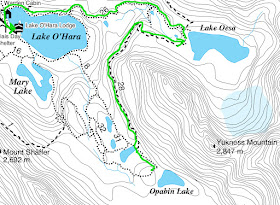Joan and I headed for the Opabin Plateau via the West Opabin trail.
Before the route began to climb I captured this shot over Mary Lake, towards All Souls Prospect and the moon.
The trail threaded along the flanks of the plateau, relentlessly headed up.
Looking back we saw a sharp demarcation between the sunny slopes and those lingering in shade.
When we reached the lip of the plateau, the valley of the west side opened up ahead of us.
We followed the west trail and then veered east towards the Terrace Pools.
Along the way the setting moon aligned with Schäffer ridge.
A ground squirrel greeted us at the edge of the pools.
A fat young american dipper was following a parent around, begging for food.
If you haven't seen a dipper at work before, or even if you have, its choreography is remarkable.
From the ponds we backtracked to the Opabin Prospect.
Although not as high as some of the surrounding prospects, Opabin still has a marvelous view.
This shot was taken from the prospect, with some of its slabs in view, over towards All Souls. That prospect is located at the shelf where the light gray and tan rocks yield to the dark gray cliffs.
Joan and I then decided to head up the plateau on the west trail, even though that meant some minor repeats.
This photo shows the layout of the ponds and cascades we had skirted earlier.
Soon we encountered the rock pile where two years before we had been charmed by several baby marmots. It happened again; this place must be a good marmot nursery.
A somewhat fuzzy closeup.
There was a final climb up to the level of Opabin Lake. This photo is of the view looking back, with the west trail and Hungabee Lake as prominent features.
Joan and I rested overlooking Opabin Lake. It was a good spot to eat the first half of our lunch.
An american pipit wondered what we were doing.
The next photo captures two trails. Below the tall bluffs is the Yukness Ledges trail, and scrambling uphill below the cliff on the right is the route to Sleeping Poets Pool, which we visited in 2015. Click on the image to enlarge.
After a short stretch on the east Opabin trail we picked up the Yukness Ledges path, which at first winds up through the boulder field hinted at in the lower right corner. We're on our way to Lake Oesa, taking the ledges counter-clockwise this time.
From the higher elevation of the ledges the Opabin Prospect looks like a thumb in the landscape.
At this western end the trail hardly needs alpine route blazes, except for the boulder field at the start.
As it rounds the first corner the route becomes rockier, more up-and-down, and the blazes become more useful.
About a third of the way across the ledges Joan and I paused to finish our lunch. There we also chatted with a young couple who had just come down from the (now defunct) Abbot Hut, a steep, challenging climb that demands gear such as a helmet and rope. The woman was glad to have done it, but never again; several times she'd been in tears at being unable to make progress up the vertiginous scree.
This is what I consider one of the classic Lake O'Hara perspectives, from the Yukness Ledges trail at the midpoint of the lake.
By now it was warm in the sun if the breeze wasn't blowing. But the breeze did deter any bugs fostered by the previous two weeks of wet weather.
This alpine route has a sharp climb or drop, depending on your direction of travel, as it rounds the eastern corner. This photo looks back at the assemblage of blazes and rocky guidelines that steer hikers approaching or leaving the edge of the climb/drop.
This brilliantly illuminated slab bore both the old-style (orange/red) and new style (two yellow bars on blue) alpine blazes. Lake Oesa is in the background.
A hiker passing the other way advised us not to miss the ducks in Lefroy Lake, the pool just below Oesa. Joan and I could see them from the ledges trail, and the water was so clear we could see the paddling feet. (I had forgotten my binoculars today, but Joan would lend me hers from time to time.) The distance was a challenge for my camera.
Lake Oesa was in full sun this afternoon.
From the edge of the lake's basin there was a grand view back to the eastern corner of the Yukness Ledges.
This map shows how the two trails, Yukness and Oesa, form a pocket whose sides face each other.
A stairway begins the trip back down to Lake O'Hara.
The ducks were still at Lefroy Lake, but most of them had hauled out onto rocks.
Then we continued on the familiar trail down to Lake O'Hara, a shower, and dinner.






























































